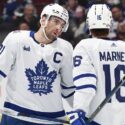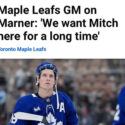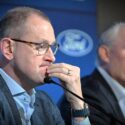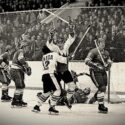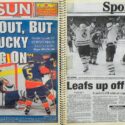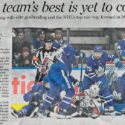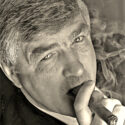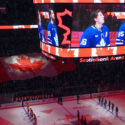TORONTO (July 14) — Whether you like Donald Trump; despise Donald Trump or don’t particularly care (and relatively few occupy the indifference category), one fact is indisputable: the former and potentially future president of the United States came within centimeters of having his head blown apart on national television. The blood on Trump’s right ear and cheek, Saturday, was probably graphic enough for young people that have no recollection of the 1960’s political climate in the U.S. I am old enough to faintly recall my late mother, Sandee, oddly planted in front of our black–and–white TV in the livingroom for hours on end. It was so unusual. Why wasn’t Mom playing games with me or looking after my two–year–old sister? What about supper? Dad would soon be home from work. None of this seemed to matter on Nov. 22, 1963, the day John F. Kennedy had his head blown off in Dallas.
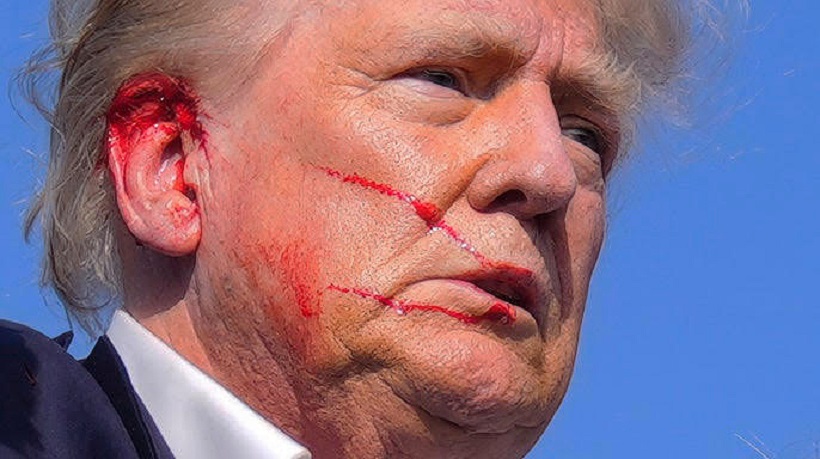
Television was still in its infancy, becoming an indispensable home item in the previous decade. The JFK assassination was the first mega–news event to be carried live, gavel–to–gavel. It climaxed, less than two days later, in the real–time murder of Kennedy suspect Lee Harvey Oswald — black–and–white TV cameras were rolling as a pair of beefy detectives led Oswald from the basement of Dallas Police Headquarters to the county jail. In an instant, a figure appeared to the right, wearing a fedora (Dallas nightclub owner Jack Ruby). Then came the sound of a single shot… and Oswald groaning loudly as he fell. If I watched it live, I was too young to remember (not yet five). But, my maternal grandmother, Bernice Robins, vividly described the moment to me some years after.
It wasn’t, however, until Mar. 6, 1975 — nearly 11½ years later — that television viewers in North America were shown the horrific image of Kennedy’s head exploding in Dealey Plaza. The fatal shot, allegedly triggered by Oswald from the sixth floor of a building kitty corner to the motorcade, had been unwittingly captured on 8mm, color film by the Bell and Howell camera of Dallas clothing manufacturer Abraham Zapruder. Only after developing the 26.6 seconds of footage from the motorcade route was it revealed that Zapruder had filmed the kill shot.
Disgustingly, it showed brain matter erupting from Kennedy’s head as he slumped to the left in the back–seat of his limousine. First Lady Jacqueline Kennedy crawled onto the rear hood of the vehicle to retrieve a portion of her husband’s skull. But, again, TV watchers did not see Zapruder’s film for more than a decade: the irreverent journalist, Geraldo Rivera, airing the full sequence on a special edition of ABC’s Good Night America. Understandably, viewers were shocked and sickened by the fatal head blow, even if the passage of time had softened the episode.

8mm FILM SHOT BY DALLAS CLOTHING MANUFACTURER ABRAHAM ZAPRUDER ON NOV. 22, 1963 SHOWS THE GRAPHIC MOMENT IN WHICH PRESIDENT JOHN F. KENNEDY’S HEAD WAS BLOWN APART BY AN ASSASSIN’S BULLET.
Imagine, therefore, the revulsion swirling in our minds today had Thomas Matthew Crooks been remotely more meticulous from his position on the roof of a low building adjacent to the farm field where Trump held his rally. If a bullet from Crooks’ rifle “tore the flesh” off the upper part of the former president’s right ear, it came within three centimeters (less than half–an–inch) of smashing into his skull, thereby offering a live, modern version of the Zapruder film. Citizens the world over would have seen portions of bone and brain matter erupting and spraying onlookers behind the podium. Secret Service agents swarming Trump would have been covered in gore. One can barely comprehend the American political process, two nights before the Republican National Convention in Milwaukee, had the party’s nominee been assassinated in cold blood; the entire globe watching as it happened.
Sadly; tragically, expressions of incredulity from Americans, today, are disingenuous.
No person aware of the incendiary rhetoric from both flanks of the political aisle could be taken aback by the attempt on Trump’s life. Many, in fact, were anticipating such a moment; my first reaction was “I knew this would happen, somewhere, some time.” Of course, I offer the perspective of a nearly 65½–year–old man who can recall prior assassination images. I mentioned the vague memory flashes of Nov. 22, 1963 after arriving home, late in the afternoon, by bus from Nursery school. Much clearer are the events, just more than two months apart, in 1968 that claimed the lives of civil rights advocate Martin Luther King and Democratic presidential frontrunner Robert F. Kennedy, younger brother of the slain leader. At nine, I was still too young to comprehend the gravity of either circumstance. Somehow, I remember being a bit disappointed by the postponement of a Stanley Cup playoff game in the wake of the King shooting (Apr. 4, 1968). I more–vividly recall sitting on the floor in my parents’ room and watching coverage of the RFK assassination attempt on the morning of June 6 in that tumultuous year. As Dad scrambled to get ready for work; popping in and out of his bedroom for updates. Kennedy had been accosted in the kitchen of a Los Angeles hotel after winning the California Democratic primary. A person identified as Sirhan Bishara Sirhan was swarmed upon by aides escorting Kennedy to his limousine. Sirhan had fired two bullets at RFK’s head from point–blank range. Somehow, Kennedy survived for nearly 24 hours before succumbing to his brain injury. I will never forget how the young girls in my Grade 3 class at Wilmington Avenue Public School openly wept when the news broke of RFK’s demise. Once more, the non–stop TV vigil prevailed. As, again, last night.
I had never heard of George Wallace on the morning (May 15, 1972) that his life nearly ended. The Alabama Governor and noted segregationist was shot four times in the chest — also from point–blank range — by Milwaukee resident Arthur Bremer (now 73). As Wallace campaigned for the Democratic presidential ticket outside a shopping mall in Laurel, Maryland. It was the first shooting to graphically appear on videotape and national TV. Remember, it would be nearly three years before the American public first viewed the Zapruder film. So, the Wallace assassination attempt (he survived, then died at 68 in January 1987) broke ground in media coverage.
Then came Mar. 30, 1981 and the most–extensively followed assassination attempt prior to Trump. The Cable News Network (CNN) had launched on June 1, 1980, less than a year earlier. It joined the established American entities (ABC, CBS, NBC) in non–stop coverage of the day Ronald Reagan nearly died. The 40th president of the United States had just spoken to a gathering at the Washington Hilton Hotel. He later exited a shipping/receiving door; the area between the building and his limousine (roughly 30 feet) remarkably devoid of security. As such, a disturbed individual named John Hinkley Jr. was able to spring from a crowd of several–hundred onlookers behind a roped–off area, 25 feet from the president. Hinkley fired five rounds, the last of which caromed off the side of Reagan’s limo and struck him in the chest. Though the president appeared fine at the outset, a Secret Service agent ran his hand inside Reagan’s shirt and discovered blood. Soon, the ol’ Gipper began to cough up a foamy, red substance, indicating a severe lung injury. He was rushed to George Washington University Hospital, arriving “right on the margin of death.” Surgeons were able to save the 70–year–old leader of the free world. But, no person of age can possibly forget the TV images (and sounds) of the moment Hinkley fired his pistol. Our televisions had immaculately relayed the near–tragic event… as it did, once more, on Saturday eve in rural Pennsylvania.

STILL IN MY COLLECTION OF PERIODICALS: AFTER JFK IN 1964 AND REAGAN IN 1981.
If not for a finger’s width of misdirection, the world, today, would be reeling from the sight of Donald Trump’s head exploding into fragments on live TV. That’s how dauntingly close we came to Zapruder–2.
EMAIL: HOWARDLBERGER@GMAIL.COM


